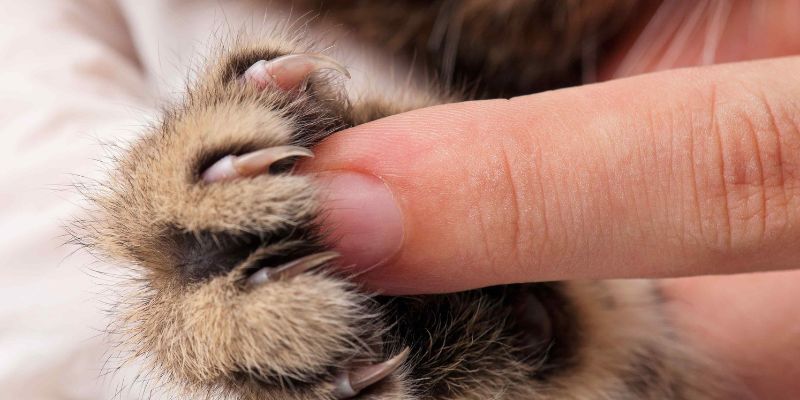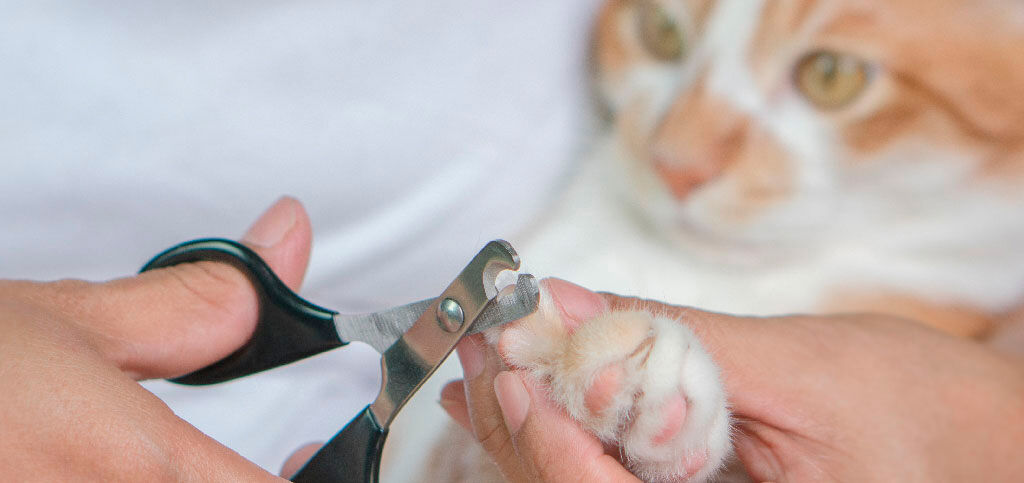If you find trimming your cat´s claws at all difficult, we would strongly advise you to speak to a vet.
You will probably have noticed that many of your cat´s most instinctive and essential behaviours involve their claws. They are used in hunting, self-defence, climbing, stretching muscles, scratching, relieving stress and marking territory. Although these are completely natural cat behaviours, they can cause damage to household objects and to the skin. Trimming the claws stops them becoming overgrown, preventing these kinds of issues. In this article, we are going explain how to do this.
When should you trim your cat’s claws?
Your cat has 18 claws (one on each toe): five claws on each front paw and four on each back paw.
They are made up of superimposed horny layers of keratin and the nail pulp, or quick, the part containing the blood vessels and nerve endings that keep the claws healthy.
The quick is slightly more opaque than the rest of the claw and is pink in colour (this is more obvious in white claws). It is vital that you know how to identify the quick in order to avoid cutting into it as this can cause your pet intense pain and bleeding.
How to know when you should trim your cat’s claws:
- If necessary, you can carry out the following process on any cat of any age.However, it is not recommended or required for outdoor cats. Remember that outdoor cats need their claws when they are out and about and to defend themselves against other animals. They will also sharpen their claws whenever they get the opportunity.
- Ideally you should start by getting your cat used to the process when they are still a kitten. By trimming their claws regularly, your cat will gradually become accustomed to the process. Kitten’s claws are softer so you will also find it easier.
- If you have an adult cat you will need to familiarise them with the process. Get them used to having their paws and toes touched so they begin to see it as something natural. Choose somewhere calm to do this and always reward good behaviour. That way, your pet will associate it with an enjoyable experience. That said, if your cat does not respond well to these first attempts, don’t force it. Simply try again another time. Remaining calm and patient is crucial.
- Your cat’s lifestyle and behaviour will determine how often you need to trim the claws. If your cat is an outdoor cat or has access to a scratching post, trimming will either be unnecessary or less frequent as your cat will wear down their claws. If your cat is a kitten, an aging cat or is ill, any reduction in mobility or activity will mean you have to trim the claws more frequently (approximately once every two weeks). Pay particular attention to the claws on the back paws. You may not have to trim these as they are often worn down more easily by themselves.
- It is important to keep an eye on how your cat’s claws grow and what your cat uses them for. This will help you work out how often your cat’s claws need to be trimmed.

Step-by-step guide to trimming your cat’s claws
- There are several styles of cat claw clippers available. Ask at your local trusted pet store to find the best option for you and your pet.
- Hold your cat firmly but gently. It might be easier if someone helps you with this.
- Using one hand, lift each of the cat’s toes and press gently on the paw pad (you will see the claws extend, allowing you to trim them easily). Now, trim the claws with your other hand.
- Make sure you only trim the transparent part of the claw. Avoid the quick. It is better to trim too little at first than too much. However, if there is any bleeding you can stop the flow by applying antiseptic styptic powder with a cotton bud.
- Reward your cat’s good behaviour and move on to the next claw!
Your cat has a variety of needs, such as claw trimming, that you must provide. If you don’t feel confident enough to do this, don’t hesitate to speak to a vet.
 Copy link
Copy link
 Publish on Facebook
Publish on Facebook
 Publish on Twitter
Publish on Twitter
 Publish on WhatsApp
Publish on WhatsApp
